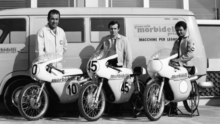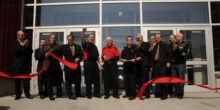Jun. 2, 2008 – Noteworthy developments in state dealer-OEM legislation
April sales from all dealerships I have information on were strong, which is good news, considering the majority of dealers for all brands were off for the first quarter. Overall retail inventory of new motorcycles and ATVs continues to be way too high. What has become clear, however, is that is not a uniform problem with metric dealers and not a problem at all with Harley dealers.
At the annual meeting of the National Council of Motorcycle Dealer Associations (NCMDA), states were asked to conduct a survey of dealers in their area. What information we have indicates the overall number for metric dealers was more than 12 months. The reports, however, showed a huge disparity. Similar brand adjoining dealers varied from 24 months to four months supply. Clearly, some dealers have been much more astute in their buying practices. OEMs will be quick to point out that any over inventory was clearly the responsibility of the dealer rather than the supplier, and other than Big Orange, that responsibility has been dumped 100 percent on the dealer.
Association managers attending the annual meeting agreed the manner in which product was distributed, the information, or lack thereof, regarding product availability and the veiled or not so veiled threats made with order requests, and the strong arm tie-ins of programs and flooring was long overdue for review. It was hoped the NCMDA could facilitate some form of industry summit, as reported in last month’s column. On April 18, the California Motorcycles Dealers Association (CMDA) offered to host the meeting and would allow OEMs to set the agenda in terms of whether the focus would be on just California and some form of compromise to head off pending legislation or a broader discussion affecting all states.
In a recent letter from the Motorcycle Industry Council (MIC), John Paliwoda, the CMDA executive director, was advised the MIC was willing to facilitate a meeting with senior OEM officials. The MIC alluded to a previous offer to the CMDA to “discuss the issues that led to your introduction of AB 2976.” The only offer anyone can recall came from a MIC staff member and did not involve senior OEM officials. The MIC was adamant about meeting only with California dealers and is clearly not willing to address distribution issues on a national basis.
Another late development comes in from Wisconsin, where similar legislation has been introduced. The chairman of the legislative committee, just as was the case in California, urged dealers to meet with OEMs to see if concerns can be resolved. Michelle Kussow, who represents the Wisconsin Dealers Association, said the MIC also has said they would facilitate a meeting, again only with dealers from the state. It may well be that dealers across the country are finally showing the determination to stand up and not accept the unilateral imposition of distribution practices not in their interest.
Hopefully the attitude of the metric OEMs (Harley has done a good job of addressing the issue directly with their dealers) is not to pretend there is no problem or just sit back and delay while their high-priced political contacts attempt to derail any new protective legislation. Metric OEMs are likely buoyed by the fact that the state associations are typically weak and that dealers have a long history of not working collectively. OEMs have received quite a shock in Montana and will find the California legislature will take note if the meetings do not take place or do not result in substantive action to at least attempt to address the issues raised by the CMDA. As I have written previously, legislation like this is a step backward, but may well be the only step open to dealers.
Even the astute metric dealers, who have been strong enough to say no, find margins eroded by the panic selling by the dealers who bought out of fear, ignorance or greed. As dealers fail this fall, we will again have three categories of inventory: current, noncurrent and regurgitated. Hopefully there will be some profit opportunity when the repossessed product is disposed of, or perhaps the weak dollar will attract buyers from abroad. In any case, pay attention, don’t try to outguess the market or assume there is any buying logic being exercised by your fellow dealers when given “free” flooring. And, remember my long-standing rule, no dealer ever went broke for what he didn’t buy.
NOT THE TIME TO BE TIMID
An old friend, who I have known for more than 30 years, wrote saying that things were indeed bad, even for a Harley-Davidson dealer. He hated the new allocation process and was convinced his only option was to reduce the hours of operation, cut expenses and ride out the bad times until things got better.
The new allocation process certainly would allow him to do just that. Harley will adjust shipments and maintain his inventory accordingly. I wrote back in the strongest terms I could and urged him to reconsider. My friend is a true salt of the earth kind of guy who has been an industry leader, giving back to the business and his community in many ways. Like so many other Harley dealers, he and his good people have been able to focus on the areas he is passionate about and have not been compelled to develop the skill sets he now needs.
There has never been a better time to be a Harley-Davidson dealer, assuming you can implement and maintain a structured sales process that gives every showroom visitor a quality experience and that you ask for and make it easy to buy. And I have been, as my wife Connie says, “putting our money where my mouth is” by financially backing aggressive new operators. The good news is for 20 years Harley dealers have spilled more than they cashed in on. All of the “tire kickers” who just seemed to get in the way of the buyers are still out there.
I urged my friend to stay open more hours, hire more salespeople, even going into the winter. I strongly suggested he stop allowing his good people to become market analysts and to worry about the only economic indicator that really matters, what happened to the last customer who came in the door.
The business is harder than it has been for a long time, but the profit opportunity is better. The business is there, if you go after it, not just with Harley. It is just not the time to be timid. psb
Ed Lemco has been involved with the powersports industry for more than 30 years. Lemco, the former owner of Lemco Management Group, is the founder and executive director of the National Council of Motorcycle Dealer Associations. Lemco currently operates a call center for dealers in St Croix.








